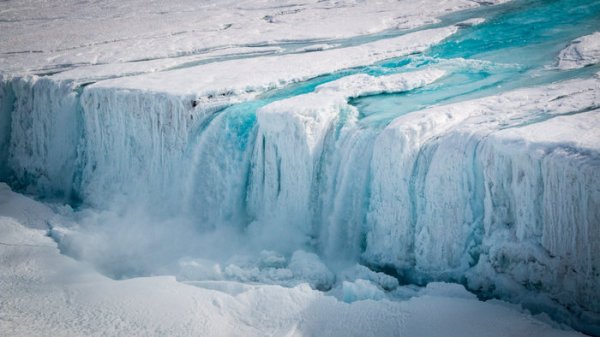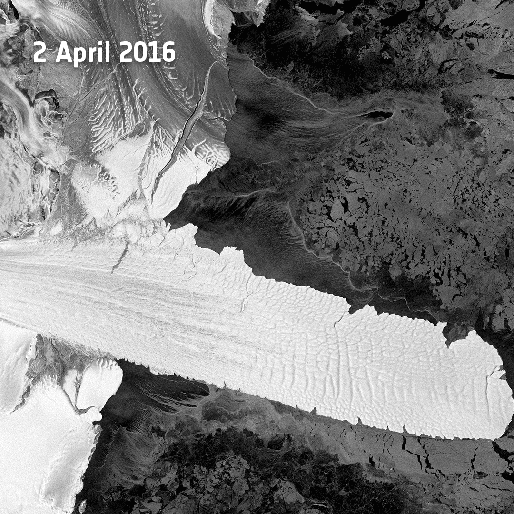Melt Expanding into East Antarctica as Nansen Ice Shelf Crack Produces 20 Kilometer Long Iceberg
25
April, 2016
Ever
since 1999 a gigantic crack has been growing in the Nansen Ice Shelf
in East Antarctica.
By 2014, expansion of the crack accelerated. As of early 2016, the
crevice had grown to 40 kilometers in length. Flooded by melt along
the Ice Shelf’s warming surface and weakened by the heating of
ocean waters from below, on
April 7th, according to ESA reports,
this East Antarctic Ice Shelf produced an immense 20 kilometer long
iceberg. A towering block of ice covering an area larger than
Manhattan floating on out toward the world’s shipping lanes.
(Surface
melt water flooding into a great crack along the Nansen Ice Shelf.
Large volumes of melt water flooding into ice shelf cracks forces
them to widen even as they dive toward union with the warming waters
below. Image source. ESA.)
The
Nansen Ice Shelf, before this most recent very large iceberg calving
event, was
a 10 mile wide and 30 mile long ice shelf that buttressed the Presley
and Reeve Glaciers of East Antarctica.
It abuts the north side of the Drygalski
Ice Tongue,
and runs out from Mount Nanson just inland of the coast of Victoria
Land,
Antarctica. And it’s yet another large shelf of ice that appears to
be facing severe weakening as global average temperatures are driven
above 1 C warmer than those experienced during the late 19th Century
by an ongoing and reckless fossil fuel emission.
Nansen
occupies a region of the world that has come under increasingly
intense observation due to a number of scientific studies
highlighting its accelerating rates of melt and a related risk of
rapidly rising global sea levels. Human-forced heating of the
world’s ocean has caused waters warm enough to accelerate glacial
melt to encroach upon Antarctica from the Southern Ocean. These
warmer waters are drawn along beneath the floating ice shelves as
fresh melt water flooding out along the ocean surface generates a
landward-moving bottom current. These warmer waters eventually push
beneath the ice shelves — eating away at their undersides.
In
West Antarctica, glaciers are seen as especially vulnerable. One
region containing the Pine Island and Thwaites glaciers — alone
capable of increasing global sea levels by 3-6 feet — is
experiencing 3-4 meters of melt along the undersides of ice shelves
each year. Meanwhile, the Pine Island Glacier’s grounding line —
the point upon which the floating ice shelf is anchored — has
retreated more than 31 kilometers further into Antarctica.
As
ice shelves and glaciers melt from below, more of the glacial mass is
floated away from the main ice mass. And since West Antarctica has a
retrograde slope, more warm ocean water comes flooding in beneath the
glaciers. As more ice calves off the glacial faces, ice fronts along
the ocean become taller. The brittle ice cannot retain structural
integrity for long and ever taller ice faces produce swifter and
swifter rates of collapse into the ocean. On the surface, warmer
conditions cause rivers of melt water to flow into cracks. The
extreme weight of the water flooding these cracks serves as a kind of
wedge — widening the cracks and shoving sea-facing sections along
the cracks into the ocean.
(Though
the most rapid rates of glacial melt dominate the Antarctic Peninsula
and the region near the Pine Island and Thwaites glaciers, increasing
rates of volume loss from Antarctic ice shelves have been creeping
into a section of East Antarctica near the Nansen Ice Shelf. With
global average temperatures now exceeding 1 C above pre-industrial,
we can expect melt and net volume loss to expand along the Antarctic
coastline. Image source:Science.)
East
Antarctica, a region occupied by Nansen, has been seen as less
vulnerable to melt from human-forced warming than West Antarctica and
the Antarctic Peninsula. That said, increasing melt rates have
progressed on into much of the Ross Sea coastal region. Though
the current very large calving event at Nansen appears to have taken
place within the expected time-frame (once every 30 years),
a context of melt is beginning to encroach. For
almost all glaciers along this section of East Antarctica show
increasing rates of ice loss.
Links:
Hat
Tip to Colorado Bob



No comments:
Post a Comment
Note: only a member of this blog may post a comment.